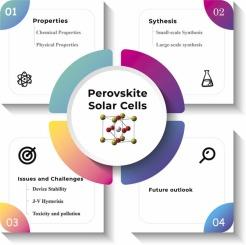当前位置:
X-MOL 学术
›
J. Alloys Compd.
›
论文详情
Our official English website, www.x-mol.net, welcomes your
feedback! (Note: you will need to create a separate account there.)
Breaking Barriers: Addressing Challenges in Perovskite Solar Cell Development
Journal of Alloys and Compounds ( IF 5.8 ) Pub Date : 2024-11-18 , DOI: 10.1016/j.jallcom.2024.177648 Maria Rani, Muhammad Mohsin Khan, Arshid Numan, Mohammed Khalid, Syed Mustansar Abbas, Mudassir Iqbal, Muhammad Adil Mansoor
Journal of Alloys and Compounds ( IF 5.8 ) Pub Date : 2024-11-18 , DOI: 10.1016/j.jallcom.2024.177648 Maria Rani, Muhammad Mohsin Khan, Arshid Numan, Mohammed Khalid, Syed Mustansar Abbas, Mudassir Iqbal, Muhammad Adil Mansoor

|
Perovskites have captured the interest of researchers for over a decade due to their high-power conversion efficiency (PCE). These materials boast excellent chemical and physical properties, making them ideal for solar cell production. On a small scale, perovskites are synthesized using various methods such as dual-source vapor deposition, one-step and two-step solution deposition, vapor-assisted solution deposition, and sequential deposition techniques. For large-scale production, industries employ techniques like inkjet printing, drop casting, blade coating, slot-die coating, and spray coating. Despite their potential, perovskite solar cells face significant challenges in commercialization, primarily due to chemical stability issues to only a few months. Therefore, recent research focuses on improving film formation and interfacial engineering to enhance device PCE and stability. To move towards commercialization, it is crucial to address degradation caused by environmental factors such as moisture and UV light through material stability improvements such as encapsulation, interface engineering, and humidity control. This necessitates the development of standardized stability tests and optimized conditions for maximum performance. This review aims to delve into the intricacies of perovskite structures and their fabrication techniques on both small and large scales. It also critically examines the challenges and obstacles in commercializing perovskites. Finally, the review offers insights into future strategies for achieving high PCE in perovskite solar cells, emphasizing the need for advanced materials engineering, robust encapsulation techniques, and scalable, cost-effective deposition methods to enhance device stability, moisture resistance, and overall longevity, paving the way for the commercialization of perovskite-based photovoltaics.
中文翻译:

打破壁垒:应对钙钛矿太阳能电池开发中的挑战
十多年来,钙钛矿因其高功率转换效率 (PCE) 而引起了研究人员的兴趣。这些材料具有出色的化学和物理特性,使其成为太阳能电池生产的理想选择。在小规模上,钙钛矿使用各种方法合成,例如双源气相沉积、一步和两步溶液沉积、蒸汽辅助溶液沉积和顺序沉积技术。对于大规模生产,工业采用喷墨打印、滴铸、叶片涂层、狭缝模具涂层和喷涂等技术。尽管钙钛矿太阳能电池具有潜力,但在商业化方面仍面临重大挑战,主要是由于化学稳定性问题,只有几个月的时间。因此,最近的研究重点是改进成膜和界面工程,以提高器件 PCE 和稳定性。为了走向商业化,通过改进封装、界面工程和湿度控制等材料稳定性来解决由环境因素(如水分和紫外线)引起的降解问题至关重要。这需要开发标准化的稳定性测试和优化的条件,以实现最佳性能。本综述旨在深入研究小尺度和大尺度钙钛矿结构的复杂性及其制造技术。它还批判性地研究了钙钛矿商业化的挑战和障碍。 最后,该综述对钙钛矿太阳能电池实现高 PCE 的未来策略提供了见解,强调了需要先进的材料工程、强大的封装技术和可扩展、具有成本效益的沉积方法,以提高器件稳定性、防潮性和整体寿命,为钙钛矿基光伏的商业化铺平道路。
更新日期:2024-11-18
中文翻译:

打破壁垒:应对钙钛矿太阳能电池开发中的挑战
十多年来,钙钛矿因其高功率转换效率 (PCE) 而引起了研究人员的兴趣。这些材料具有出色的化学和物理特性,使其成为太阳能电池生产的理想选择。在小规模上,钙钛矿使用各种方法合成,例如双源气相沉积、一步和两步溶液沉积、蒸汽辅助溶液沉积和顺序沉积技术。对于大规模生产,工业采用喷墨打印、滴铸、叶片涂层、狭缝模具涂层和喷涂等技术。尽管钙钛矿太阳能电池具有潜力,但在商业化方面仍面临重大挑战,主要是由于化学稳定性问题,只有几个月的时间。因此,最近的研究重点是改进成膜和界面工程,以提高器件 PCE 和稳定性。为了走向商业化,通过改进封装、界面工程和湿度控制等材料稳定性来解决由环境因素(如水分和紫外线)引起的降解问题至关重要。这需要开发标准化的稳定性测试和优化的条件,以实现最佳性能。本综述旨在深入研究小尺度和大尺度钙钛矿结构的复杂性及其制造技术。它还批判性地研究了钙钛矿商业化的挑战和障碍。 最后,该综述对钙钛矿太阳能电池实现高 PCE 的未来策略提供了见解,强调了需要先进的材料工程、强大的封装技术和可扩展、具有成本效益的沉积方法,以提高器件稳定性、防潮性和整体寿命,为钙钛矿基光伏的商业化铺平道路。


















































 京公网安备 11010802027423号
京公网安备 11010802027423号